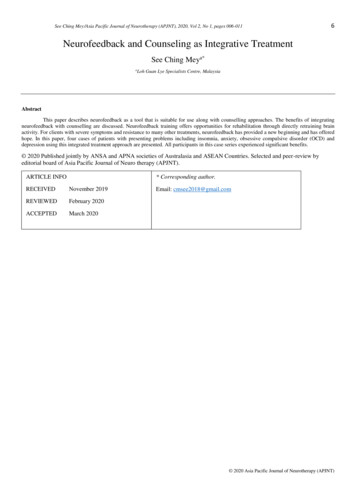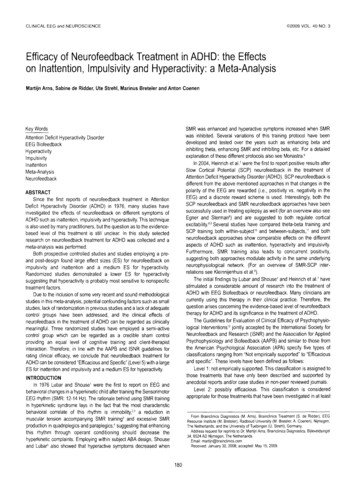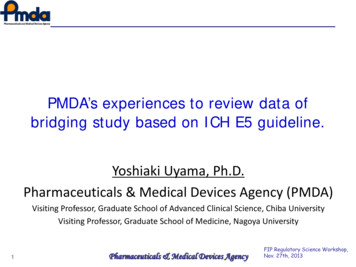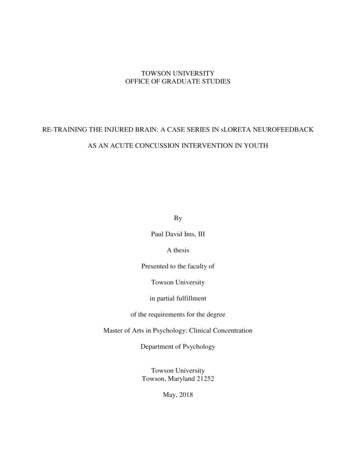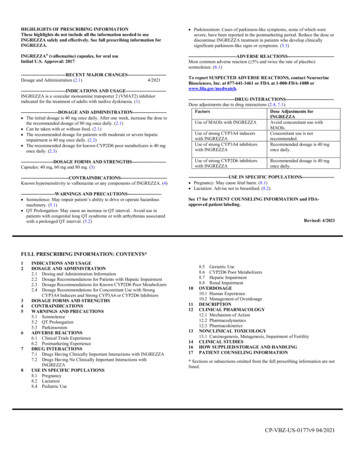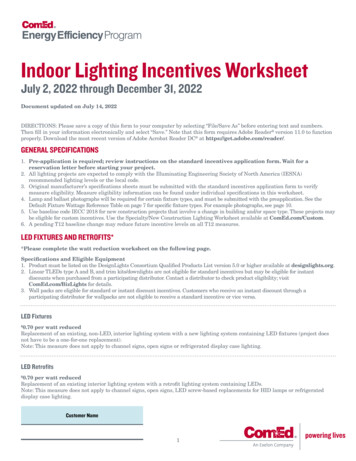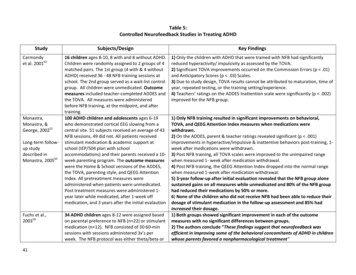
Transcription
Table 5:Controlled Neurofeedback Studies in Treating ADHDStudyCarmondyet al. 200163Monastra,Monastra, &George, 200255Long-term followup studydescribed inMonastra, 200565Fuchs et al.,20035641Subjects/DesignKey Findings16 children ages 8-10, 8 with and 8 without ADHD.Children were randomly assigned to 2 groups of 4matched pairs. The 1st group (4 with & 4 withoutADHD) received 36 - 48 NFB training sessions atschool. The 2nd group served as a wait-list controlgroup. All children were unmedicated. Outcomemeasures included teacher-completed ADDES andthe TOVA. All measures were administeredbefore NFB training, at the midpoint, and aftertraining.100 ADHD children and adolescents ages 6-19who demonstrated cortical EEG slowing from acentral site. 51 subjects received an average of 43NFB sessions, 49 did not. All patients receivedstimulant medication & academic support atschool (IEP/504 plan with schoolaccommodations) and their parents received a 10week parenting program. The outcome measureswere the Home & School versions of the ADDES,the TOVA, parenting style, and QEEG AttentionIndex. All pretreatment measures wereadministered when patients were unmedicated.Post treatment measures were administered 1year later while medicated, after 1-week offmedication, and 3 years after the initial evalaution1) Only the children with ADHD that were trained with NFB had significantlyreduced hyperactivity/ impulsivity as assessed by the TOVA.2) Significant TOVA improvements occurred on the Commission Errors (p .01)and Anticipatory Scores (p .03) Scales.3) Due to study design, TOVA results cannot be attributed to maturation, time ofyear, repeated testing, or the training setting/experience.4) Teachers’ ratings on the ADDES Inattention scale were significantly (p .002)improved for the NFB group.34 ADHD children ages 8-12 were assigned basedon parental preference to NFB (n 22) or stimulantmedication (n 12). NFB consisted of 30 60-minsessions with sessions administered 3x’s perweek. The NFB protocol was either theta/beta or1) Only NFB training resulted in significant improvements on behavioral,TOVA, and QEEG Attention Index measures when medications werewithdrawn.2) On the ADDES, parent & teacher ratings revealed significant (p .001)improvements in hyperactive/impulsive & inattentive behaviors post-training, 1week after medications were withdrawn.3) Post NFB training, all TOVA scales were improved to the unimpaired rangewhen measured 1- week after medication withdrawal.4) Post NFB training, the QEEG Attention Index dropped into the normal rangewhen measured 1-week after medication withdrawal.5) 3-year follow-up after initial evaluation revealed that the NFB group alonesustained gains on all measures while unmedicated and 80% of the NFB grouphad reduced their medications by 50% or more.6) None of the children who did not receive NFB had been able to reduce theirdosage of stimulant medication in the follow-up assessment and 85% hadincreased their dosage.1) Both groups showed significant improvement in each of the outcomemeasures with no significant differences between groups.2) The authors conclude “These findings suggest that neurofeedback wasefficient in improving some of the behavioral concomitants of ADHD in childrenwhose parents favored a nonpharmacological treatment”
Heinrich et al.200457Rossiter, 200458deBeus, 2006;51deBeuss & Kaiser,42SMR training dependent the child’s subtype ofADHD. The doses for the medication group wereadjusted during study based on need and rangedbetween 10 and 60 mg/day. The outcomemeasures were the TOVA, Attention EnduranceTest, parent & teacher rated CBRS, and the WISC.22 ADHD children ages 7-13 were assigned to NFB(n 13) and a wait-list control group (n 9). TheNFB children received 25 SCP training sessionsover the course of 3 weeks. Starting at week 2,the NFB children were instructed to practice theirstrategies at home. The outcome measures werethe parent rated FBB-HKS, CPT, and event-relatedpotential (P300) during CPT.62 ADHD children and adults ages 7-55 werematched to NFB (n 31) or stimulant medication(n-31) based on patient or parent preference.Patients were matched by (in order) age, sum of 4baselineTOVA scores, IQ, gender, and ADHD subtype. Themedication patients were titrated based on TOVAresults and maintained on the dose thatmaximized TOVA scores. The NFB patientsreceived either 40 sessions in office or 60 at homeover 3-3.5 months. The NFB theta/beta protocolwas on the left hemisphere for those patientsreporting inattention, daydreaming, poorsustained attention, and/or lack of motivationwhereas those also reporting impulsivity,distractibility, and/or stimulus-seeking receivedleft and right hemisphere training. The outcomemeasures were the TOVA for both groups and forthe NFB group only either a child or adult ADHDrating scale53 ADHD children ages 7-11 were randomlyassigned in a cross-over design to first receive1) SCP training resulted in significant reductions in core ADHD symptoms asrated by parents.2) SCP training resulted in significant improvements in the more objectivelaboratory measures compared to those children in the wait-list control group.3) The authors concluded that “this study provides first evidence for bothpositive behavioral and specific neurophysiological effects of SCP training inchildren with ADHD.”1) Both the NFB and stimulant medication groups had similar significantimprovements in attention, impulsivity, and processing speed on the TOVA withno significant differences between groups.2) The NFB group demonstrated statistically and clinically significantimprovement on behavioral measures (Behavior Assessment System forChildren, ES 1.16, and Brown Attention Deficit Disorder Scales, ES 1.59).3) The author concluded that “confidence interval and nonequivalence nullhypothesis testing confirmed that the neurofeedback program producedpatient outcomes equivalent to those obtained with stimulant drugs.”1) NFB was superior to sham feedback on the IVA’s response control andattention scales, on the CPRS’s inattentive scale, and the CTRS’s inattentive &
201152Levesque et al,200659Strehl et al,200653Drechsler et al,20075443either 20 30-minute theta/beta NFB sessions or 20sham NFB sessions. After these sessions, thechildren who had received active NFB received 20sham sessions & those who had received shamNFB received 20 sessions of theta/beta NFB.Children were assessed after each block of 20sessions. Outcome measures included the IVA,parent-rated CPRS, and teacher-rated CTRS.20 ADHD children ages 8-12 were randomlyassigned on a 3:1 ratio basis. The 15 NFB childrenreceived 40 sessions of theta/beta training while 5children were waitlisted. Outcome measuresincluded pre/post changes in fMRI, Digit Spansubtest of the WISC, IVA, CPRS Inattention andhyperactivity scales, Counting Stroop and Go/NoGo Tasks.25 ADHD children ages 8-13 received 30 SCP NFBsessions lasting 60 minutes in 3 phases of 10sessions each. Transfer trials without SCPfeedback were intermixed with feedback trials tofoster generalization of treatment effects. Inaddition to the NFB sessions, in the third phasechildren practiced their SCP self-regulationstrategy during homework. Outcome measuresincluded parent and teacher ratings of ADHDsymptoms (DSM questionnaire for ADHD; EybergChild Behavior Inventory; CPRS, and CTRS), IQ(WISC), and a computerized measure of attention.30 ADHD children age 7-13 were partiallyrandomized to NFB (n 17) and a group forcognitive behavioral training CBT (n 13). Therandomization allowed therapeutic/practicalaspects to be accounted for (e.g., limited agerange for children in each group, gender-mixedgroups had to have at least 2 of each gender,hyperactive-impulsive scales.2) Of the 42 children who completed all 40 sessions, 31 were classified as NFBlearners because their theta/beta EEG ratio improved in the desired direction byone-half a standard deviation or more following active NFB and 11 wereclassified as NFB non-learners.3) NFB-learners were superior to non-learners on the IVA’s response controland attention scales and the CTRS’s inattentive, hyperactive-impulsive, andADHD total score scales.1) On the fMRI, NFB resulted in significant activation of the right anteriorcingulate cortex (ACC), right ventrolateral prefrontal cortex, right dorsal ACC,left caudate nucleus, and left substantia nigra whereas no significant changeswere seen in the control group.2) NFB was superior on each of the other outcome measures.3) The authors concluded that NFB “has the capacity to functionally normalizethe brain systems mediating selective attention and response inhibition.”1) Children with ADHD can learn to regulate slow negative cortical potentials.2) Children’s ability to successfully produce SCP shifts in trials without feedbackhad better clinical outcomes than those children who were less successful.3) Parents and teachers reported significant behavioral and cognitiveimprovements for the children following SCP training.4) After SCP training, significant improvements in attention and performance IQscore were also observed.5) The positive changes in parent and teachers ratings, attention, and IQcontinued when reassessed 6 months after SCP treatment ended.While this is was not a controlled study, it was included because of its reportof 6-month follow-up results and correlating the children’s improvement inlearning to regulate SCP and to having better clinical outcomes.1) NFB was superior to CBT in the parent and teacher ratings, particularly in theattention and cognition-related domains.2) Children in both groups showed similar improvement on theneuropsychological measures, however only about half of the NFB grouplearned to regulate cortical activation during the transfer condition withoutdirect feedback. Behavioral improvements of this subgroup were moderatelyrelated to NFB training performance, whereas effective parental support
Leins et al, 200749Gani et al, 2008for 2-year followup6644children/parents of the NFB group had to beavailable during vacation for intense training, andsome children/parents expressed strongpreference for one type of training or wanted toparticipate in both groups—in these latter casesonly the data from the 1st treatment was includedfor analysis). The CBT groups had 15 90-minsessions, once or twice per week and includedsocial skills training, self-management,metacognitive skill training, and training toenhance self-awareness. Parents were invited toparticipate in the last 15-minutes of each session.The NFB group had 30 45-minute SCP trainingsessions twice per day for 2 weeks, followed by a5-week break, then 5 double sessions, once ortwice per week for 3 weeks. Parents and childrenwere taught how to practice generalizing SCPactivation/deactivation to real life situations.Outcome measures included parent and teacherrated ADHD symptoms (FBB-HKS, CPRS, CTRS,BRIEF), neuropsychological measures foralertness, inhibitory control, selective attention,sustained attention, and switching attention usingthe TAP and subtest scores from TEA-ch). Learningcortical self-regulation was evaluated bycomputing the difference between activationduring sessions 2 and 3 vs 13 and 14. Parentinvolvement was assessed via self-report andinvolvement in CBT and NFB trainingopportunities.38 ADHD children age 7-13 were matched by age,sex, IQ, dx, and medication status and thenrandomly assigned either theta/beta NFB (n 19)or SCP NFB (n 19). NFB training for both groupsconsisted of 30 60-minute sessions divided into 32-week phases of 10-session each separated by aaccounted better for some advantages of NFB training compared to CBT grouptherapy according to parents' and teachers' ratings3) The authors concluded that “there is a specific training effect ofneurofeedback of slow cortical potentials due to enhanced cortical control.However, non-specific factors, such as parental support, may also contribute tothe positive behavioral effects induced by the neurofeedback training.”1) Both NFB groups learned how to intentionally regulate cortical activityconsistent with their training and significantly improved in attention and IQ.2) Parents and teachers reported significant behavioral and cognitiveimprovements for the children in both NFB groups.3) The NFB groups did not differ in behavioral or cognitive outcomes.4) The clinical effects for both NFB groups remained stable six months after
Holtmann et al,200960454 to 6 week break for home practice. For bothgroups, 23% of the NFB sessions were spent ontransfer trials in which the subjects attempted toactivate the targeted EEG via self-regulation onlywithout real-time feedback and only learned ifthey were successful after the end of the transfertrial. Both groups also were taught transferexercises to practice at home during the four tosix week breaks between the first two blocks of 10NFB sessions. The children were taught how touse their self-regulation strategies for EEGactivation in everyday life situations especially inproblematic ones such as doing homework or inschool where sustained attention andconcentration are required. The home trainingexercises included the use of memory aids.During the third block of 10 sessions, the subjectspracticed exercising activation while doing theirhomework at the end of each NFB session underthe supervision of the NFB trainer. Three boostersessions were also administered as part of the 6month and 2-year follow-up assessments andused to calculate EEG self-regulation skills.Outcome measures included parent and teacherratings of ADHD symptoms (DSM questionnairefor ADHD; Eyberg Child Behavior Inventory; CPRS,and CTRS), IQ (WISC), and for the SCP NFB group,SCP amplitude during activation and deactivationtasks; and for the theta/beta group the theta/betaratio during activation and deactivation tasks.34 ADHD children, age 7 to 12, were randomlyassigned on a 3:2 ratio basis to receive either 20theta/beta NFB sessions (N 20) or 20 sessions ofCaptain’s Log (N 14), a cognitive training softwareprogram. All children also received a 2-weekintensive behavioral day clinic, weekly parenttreatment termination.5) In the 2-year follow-up, all improvements in behavior and attention that hadbeen observed at previous assessments remained stable with further significantreductions in the number of reported problems and significant improvement inattention.6) EEG-self regulation skills were maintained for the children in both groupswhen reassessed 2 years after NFB treatment ended.7) In each NFB group, half of the children no longer met the criteria for ADHDand only 22% were talking medication for ADHD.8) The authors concluded that, “neurofeedback appears to be an alternative orcomplement to traditional treatments. The stability of changes might beexplained by normalizing of brain functions that are responsible for inhibitorycontrol, impulsivity and hyperactivity.”1) Only NFB resulted in normalization of a key neurophysiologic correlates ofresponse inhibition.2) Only NFB resulted in a significant reduction in impulsivity errors on the StopSignal test.3) There were no differential effects on parent ratings.4) The combination of both groups receiving intensive all-day behavior therapy
Gevensleben etal., 2009a48;2009b50; Wangleret al, 201172;Gevensleben etal., 2010 for 6month follow-up64Bakhshayesh etal, 20116146training, and 79% were on medication for theirADHD. Outcome measures included pre/postchange on Stop-Signal test, a neurophysiologicmeasure of response inhibition (Go/NoGo-N2),and the parent-rated SNAP-IV.and 79% of the children being on medication may have attenuated the ability toshow differences between treatment groups on the parent ratings.102 ADHD children, age 8 to 12, were randomlyassigned on a 3:2 ratio basis to receive either 36sessions of NFB or 36 sessions of Skillies, anaward-winning German cognitive trainingsoftware program. The 62 NFB children werefurther randomized to receive first either a blockof 18 theta/beta training sessions OR 18 slowcortical potential (SCP) training sessions and toswitch protocols for the second block of 18 NFBsessions. Outcome measures were German ratingscales (FBB-HKS and FBB-SSV) blindly administeredto teachers and parents at baseline, after 18, and36 sessions. Pre/Post changes in EEG wereassessed along with 6-month follow-up data forthe two-thirds of children who had not droppedout or started some other treatment.1) Only NFB produced significant changes in EEG and these changes werespecific to each form of NFB training and furthermore, were associated withimprovements on the ADHD rating scales.2) On the parent and teacher rating scales, improvements in the NFB groupwere superior to the Skillies group for reducing: Overall ADHD symptoms (p .005 & p .01, both respectively) Inattention (p .005 & p .05, both respectively) Hyperactivity/Impulsivity (p .05 & p .1, both respectively) Oppositional Behavior (p .05, parent rating only) Delinquent & PhysicalAggression (p .05, parent rating only).3) No significant differences in effects were found between the two NFBprotocols (theta/beta training & SCP training).4) Overall, at the 6-month follow-up the NFB group continued theirimprovements compared to the Skillies group.5) Finally, as only 50% of the NFB group was classified as treatmentresponders, the authors concluded that “though treatment effects appear to belimited, the results confirm the notion that NFB is a clinically efficaciousmodule in the treatment of children with ADHD.”1) Training effectively reduced theta/beta ratios and EMG levels in the NF andBF groups, respectively.2) Compared to EMG biofeedback, NFB significantly reduced inattentionsymptoms on the parent rating scale and reaction time and concentration onthe neuropsychological measures.3) While children in both groups made significant improvements on mostmeasures thereby making it difficult with such a small N for NFB to separatefrom EMG biofeedback, in ALL 11 outcome measures (and subscales thereof),the level of improvement was greater for NFB and a non-parametric binomialtest would find this highly significant.4) Besides lowering muscular tension, EMG biofeedback teaches attention,which may further reduce the difference in outcomes.35 ADHD children, age 6 to 14, were randomlyassigned to receive either 30 theta/beta NFBsessions (N 18) or 30 sessions ofelectromyography (EMG) biofeedback (N 17).Single-blinded RCT. Outcome measures includedpre/post change on parent and teacher ratingsusing the FBB-HKS; CPT; The bp and d2 attentiontests; and changes in the theta/beta ratio andEMG amplitude.
Duric et al, 201262130 ADHD children and adolescents, ages 6 to 18,were randomly assigned to receive either 1) NFB,2) methylphenidate, or 2) combinedNFB/medication. After randomization 39 droppedout (36 immediately after randomization) 13 fromthe NFB group, 15 from the medication group, 11from the combined group resulting in 91completing the study; NFB (n 30),methylphenidate (n 31), and combined (n 30).The NFB group received 30 40-minute theta/betasessions 3 times per week for 10 weeks. Thesubjects in the medication and combined grouptook methylphenidate) twice per day at therecommended dose of 1 mg per kg with the finalmedication doses from 20 to 60 mg daily.Outcome measures were the inattention andhyperactivity subscales of the parent-ratedCMADBD-P (& total score) with the post ADBD-Padministered one week after the final NFB sessionfor those in the NFB and combined groups.1) The parents reported highly significant effects of the treatments in reducingthe core symptoms of ADHD, but no significant differences between thetreatment groups were observed.2) Although not significant, the NFB group showed more than double the pre–post change in attention compared with the other two treatments (3.1 vs. 1.1and 1.5 for the means) and NFB’s effect size was larger than the other twotreatments on both the inattention and hyperactivity subscales and total scoremeasures.3) The authors conclude that, “NFB produced a significant improvement in thecore symptoms of ADHD, which was equivalent to the effects produced bymethylphenidate, based on parental reports. This supports the use of NFB asan alternative therapy for children and adolescents with ADHD.”AbbreviationsBehavior Rating ScalesTests of AttentionTests of IntelligenceADDES Attention Deficit Disorder Evaluation ScaleBRIEF Behavior Rating Inventory for Executive FunctionCBRS Conners Behavior Rating ScaleCMADBD-P Clinician’s Manual for the Assessment of DisruptiveBehavior Disorders – Rating Scale for ParentsCPRS Conners Parent Rating ScaleCTRS Conners Teacher Rating ScaleFBB-HKS German Rating Scale for ADHDFBB-SSV German Rating Scale for Oppositional Defiant/ConductDisordersCPT Continuous Performance TestIVA Integrated Visual and Auditory continuousperformance taskTOVA Test of Variables of AttentionTAP Test for Attentional Performance; TEA-chWISC Wechsler Intelligence Scale forChildren47
ADHD. The doses for the medication group were adjusted during study based on need and ranged between 10 and 60 mg/day. The outcome measures were the TOVA, Attention Endurance Test, parent & teacher rated CBRS, and the WISC. Heinrich et al. 200457 22 ADHD children ages 7-13 were assigned to NFB (n 13) and a wait-list control group (n 9). The

